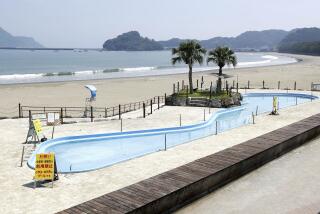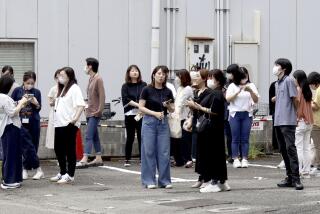Grim recovery effort along Japan’s coast
- Share via
Reporting from Sendai, Japan — -- A smashed white pickup wedged beneath another vehicle was marked “Day 13, 3:15 p.m.” in Japanese characters.
The numbers indicated the day of the month and time two bodies had been found inside the truck. A team of eight soldiers struggled to remove the unidentified corpses from the truck’s cab Sunday. They lifted them onto a soggy tatami mat, covered them with a blue and yellow blanket, then heaved the load onto their flatbed army truck.
“Push it back farther,” Japanese Self-Defense Forces officer Tomonori Yoshinaga told the men. “We still have more to go.”
Photos: Scenes of earthquake destruction
A few minutes later, they found another body, rigor mortis fixing it in a sitting position, within the mess left by the earthquake and tsunami that slammed Sendai, a coastal city in northeast Japan, shortly after 2:30 p.m. Friday.
“This work is heartbreaking,” said Yoshinaga, a large army phone system on his back, before heading off to the next site.
Throughout Sendai, as emergency crews and officials began to get a clearer look at the degree of damage in one of the worst-hit areas, residents struggled with the aftermath of nature’s fury in their own ways. Some searched for loved ones, nearly all worried about food, water or housing, while others tried to resume normal lives in the midst of overwhelming scenes of devastation.
At the Sendai airport, where the tsunami waves plowed through the runways, the parking lot early Monday looked like the mess made by an angry toddler dumping his toy cars in the mud willy-nilly. A small plane rested with its nose wedged against a railing amid heaps of late-model Subarus and Toyotas that still glinted through the mud and twigs.
Behind an airport warehouse, workers pointed to a body in a ditch. As an ambulance crew with a stretcher removed what appeared to be the remains of a middle-aged man, one of his arms poked out from under a fuzzy pink blanket as though he had been holding a cellphone.
“We are under orders to find people. Survivors or victims. I don’t think there is anybody alive but we will look,” said one military officer in uniform.
In the downtown area, the office towers glistened in the morning sunlight. One could see barely any obvious trace of Friday’s disaster. But the stark modernity of 21st century Japan made the deprivation more startling.
Residents with shopping bags waited in a queue that, except for the people’s immaculate clothing, looked straight out of the Soviet Union. The only store operating was a Lawson’s convenience shop. The sliding glass doors opened every few minutes to admit five customers; they were each permitted to buy two bottles of mineral water and two packages of noodles.
“We’re getting worried now. There is no food, no water,” said Hitomi Auzai, 25, an engineering student. “It’s almost three days now.”
The destruction in the Natori area of Sendai included jumbles of splintered wood and mounds of mud, so much mud. The possessions that once amused and comforted residents now lay half-buried and provided a vivid reminder of nature’s wrath, its ability to snuff out lives in an instant.
The devastation had left a down-the-rabbit-hole world, where up is down, with boats resting on roads and cars seemingly parked in the water.
The handiwork of the wall of water has left much of the building debris, smashed furniture and upended street lamps bunched up into tight clumps as the tsunami receded almost as quickly as it arrived.
The noses of two cars slanted skyward against each other, forming an improbable triangle. The guts of houses pushed out through broken windows where the water left, held in place by nothing but the twisted remnants of venetian blinds. Wheelchairs and deflated soccer balls, bottles and plastic remain embedded in once-pristine rice fields, making a mockery of the order that Japan craves, a monster force from the oceans it depends on for food and foreign trade.
Makiko Oshiro, a volunteer search and rescue worker, walked through the wasteland with a tiny red dog on a leash that looked too small to sniff out anyone who might somehow still be alive. She had just found the dog wandering around a nearby field of debris, itself a rare survivor. It was scared, lost and missing its owners.
“Today’s the first day the water receded enough to search,” she said, her boots mired in mud. “But we’re only finding bodies. I don’t see much hope anyone could live through this. We’ll probably find hundreds more bodies under there before we’re done.”
A few hundred yards away, Fumiyo Saito, 70, a retiree, emerged from a battered house. He had spent the afternoon looking for his missing cousin and brother-in-law. The house was badly damaged, but was still standing. “That gives me a little hope they’re still alive.” he said.
As he moved on, a helicopter flew overhead and soldiers struggled to unearth a narrow lane lost under the mess. A massive piece of construction equipment with tank tracks and a powerful claw that could be used to dig out the living was getting much less use than a blunt bulldozer more suited to shoving and pushing debris with little precision.
All around was evidence of nature’s seemingly capricious hand, an occasional house left standing while the rest of the neighborhood had floated away. The mud-caked appliances, splintered guitars and torn easy chairs only hinting at the destructive power that slammed the village.
Haruo Endo, 58, stood on her porch pulling towels from a clothesline Sunday afternoon, surrounded by wreckage and sadness and loss in a vain attempt to impose order on the sea of chaos.
A homemaker, she had been in her car nearby when the earthquake struck. She heard the warning siren wail and raced for higher ground. The next thing she remembers, she was watching images of the disaster unfold on her tiny dashboard TV.
“I lived here 20 years and never imagined such destruction was possible,” she said, reaching down to comfort her anxious grandchild. “We have insurance, but I don’t know how much it will cover. Our cousin used to live just there [down the street]. They’re still alive, but their house is gone. The sea just took it away.”
Photos: Scenes of earthquake destruction
More to Read
Sign up for Essential California
The most important California stories and recommendations in your inbox every morning.
You may occasionally receive promotional content from the Los Angeles Times.










